Customizable Color Options for Thermoplastic Paint for Road Marking Standards Compliance
Product Description
1. Composition:
- Binder: Includes thermoplastic resins like hydrocarbon resin or maleic resin for adhesion and durability.
- Pigments: Provides color (e.g., titanium dioxide for white, iron oxide for yellow).
- Fillers: Calcium carbonate or other materials to increase volume and reduce cost.
- Glass Beads: Enhance reflectivity for night visibility.
- Additives: Anti-settling agents, stabilizers, and adhesion enhancers.
2. Standards:
- Must comply with international or local standards like BS 3262, AASHTO M249, or other road marking paint specifications.
3. Physical Properties:
- Color: White, yellow, or custom as required.
- Density: ~2.0 g/cm³.
- Melting Point: ~180-220°C.
- Drying Time: Quick-drying within 3-5 minutes after application.
- Skid Resistance: Minimum of 45 BPN (British Pendulum Number).
4. Performance:
- Adhesion: Strong bonding with asphalt or concrete surfaces.
- Durability: Long-lasting, resistant to weather and wear.
- Reflectivity: High retro-reflectivity with glass beads.
- Heat Stability: Withstands high application temperatures without degradation.
5. Application Requirements:
- Application Temperature: 180-220°C.
- Thickness: Typically 1.5-2.5 mm (as per project requirements).
- Pre-treatment: Road surface should be clean and dry before application.
6. Packaging:
- Supplied in bags or containers, typically 25 kg/bag.
- Ensure proper storage in a cool, dry place.
If you need a specific technical datasheet or detailed customization for your project, feel free to provide additional requirements!
Detailed Process of Thermoplastic Paint Construction
1. Prepare the Surface
- Cleaning: Ensure the surface is free of dirt, grease, oil, dust, and loose debris.
- Repair: Fix cracks or uneven areas to create a smooth surface.
- Drying: The surface must be dry to ensure proper adhesion
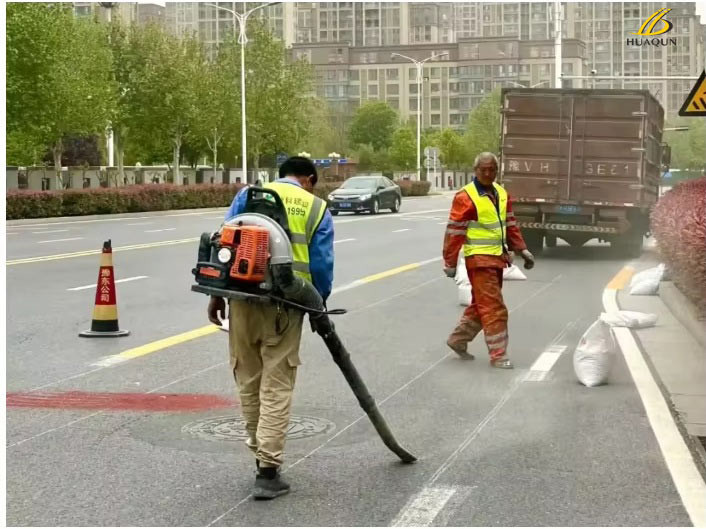
2. Mark the Layout
- Use chalk, tapes, or temporary markers to outline the areas to be painted (lines, symbols, or shapes).
- Verify measurements against specifications or local standards.
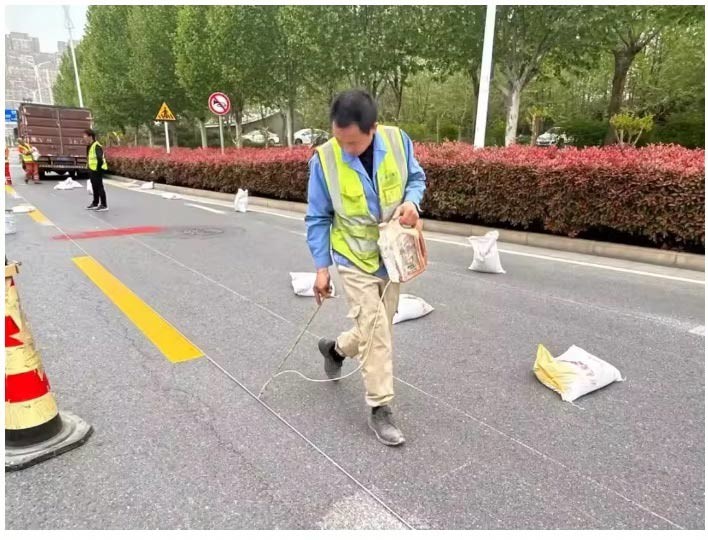
3. Heat the Thermoplastic Paint
- Use a melting kettle or thermoplastic preheater to melt the paint.
- Heat to the recommended temperature, typically 180–220°C (356–428°F).
- Avoid overheating, as it may degrade the paint and affect quality.
- Stir continuously to ensure uniform consistency.
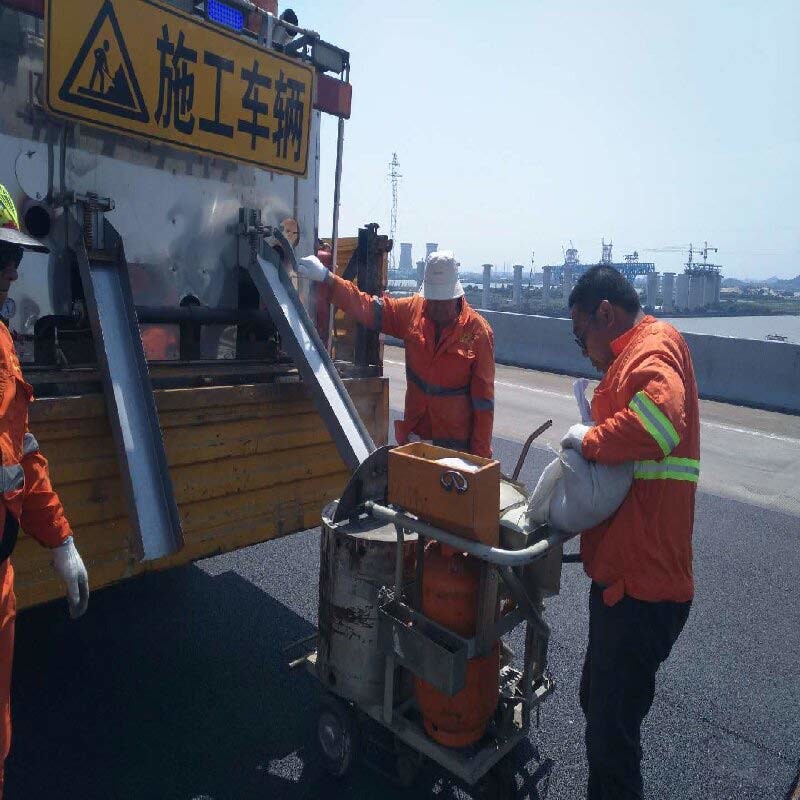
4. Primer Application (if required)
- Apply a primer to the surface if recommended by the manufacturer.
- This is especially needed for non-porous surfaces like concrete or asphalt.
- Allow the primer to dry before applying the paint.
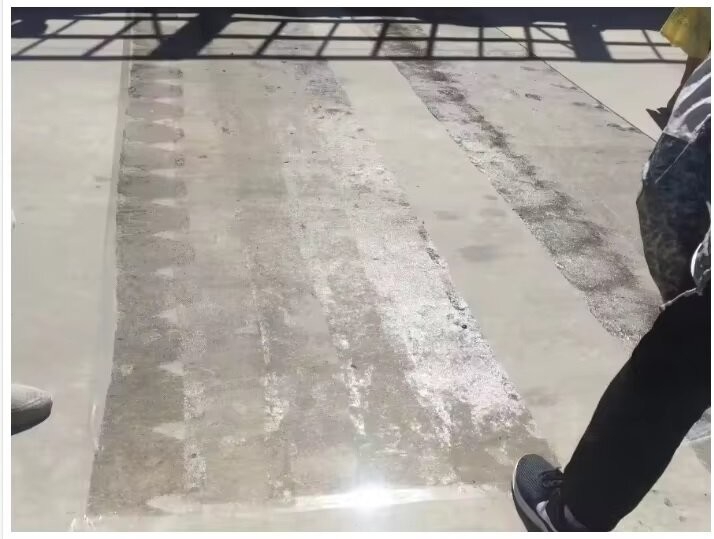
5. Apply the Paint
- Screed Method: Use a screed box to create uniform thickness for road markings.
- Spray Method: Use a spray machine for even application on large or irregular areas.
- Extrusion Method: For thicker, raised markings.
- Hand Application: For small areas or repairs, manually pour and spread the molten paint.
- Preformed Thermoplastic: Lay pre-cut sheets or symbols on the surface and heat with a propane torch until adhered.
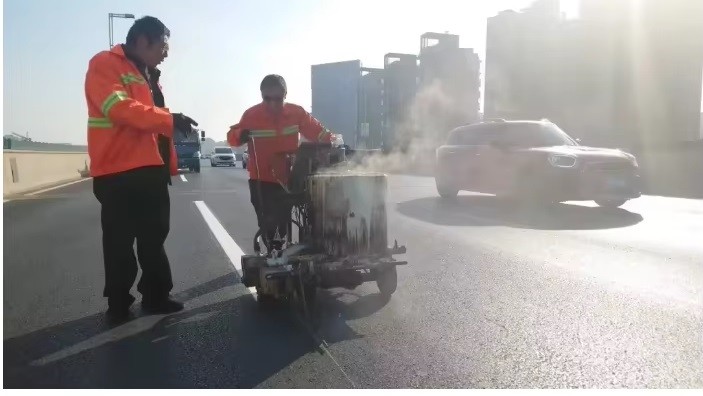
6. Check and Correct
After the coating is completed, check and correct the line shape, check the spread of glass beads, etc.
After confirming that it is correct, the construction site will be cleaned up.
After the line is dried and hardened, the relevant construction equipment can be transferred, the safety facilities can be dismantled, and the traffic can be opened.

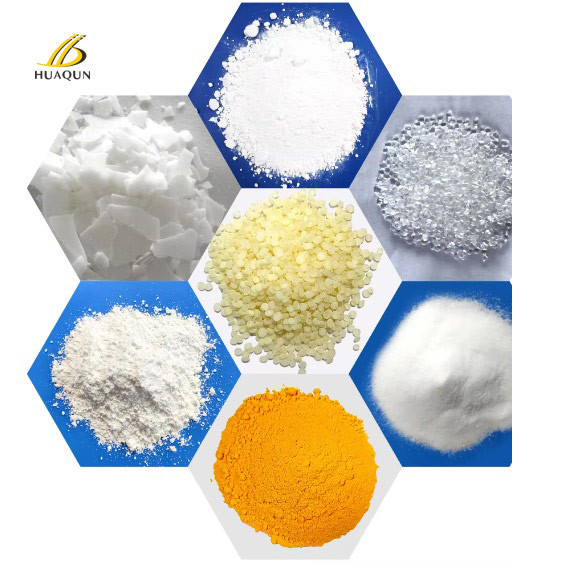


| Customized Formula |
| Customized Formula | Content(Customized range) | Characteristics |
| C5 Resin | 10%-22% | Fluidity Toughness Hardness Adhesion |
| Titanium Dioxide | 0.5-10% | 0.5%-30% |
| Premixed glass beads | 0%-30% | Reflective after surface wear |
| Calcium Carbonate Sand | 30%-80% | Whiteness Wear-resistant Hardness |
| PE Wax | 1%-1.5% | Cold and heat resistant |
| EVA | 0.5%-1% | Crack resistance |
| Plasticizer | 1%-1.5% | Toughness |
Tips for Safe and Effective Application
- Protective Gear: Wear gloves, heat-resistant clothing, and safety goggles.
- Temperature Control: Monitor paint temperature to avoid overheating.
- Traffic Management: Use barricades or warning signs to manage traffic during application.
- Weather Conditions: Avoid application during rain or extreme temperatures.
By following these steps, thermoplastic paint can be effectively applied to create durable, high-quality road or surface markings.
How to Select Suitable Thermoplastic Paint
Choosing the right thermoplastic paint for road marking depends on several factors to ensure durability, visibility, and compliance with standards. Here are the key considerations:
1. Application Environment
- Climate Conditions: Consider weather conditions such as temperature, humidity, and rainfall. Some paints are specifically formulated for extreme temperatures or high-moisture areas.
- Traffic Volume: High-traffic areas require more durable paints with better wear resistance.
- Surface Type: Ensure compatibility with the road surface material (e.g., asphalt or concrete).
2. Performance Requirements
- Durability: Select a paint with high resistance to wear and tear, especially for heavy-traffic roads.
- Reflectivity: Opt for paints that allow for the embedding of glass beads to enhance nighttime visibility.
- Skid Resistance: For safety, especially in wet conditions, choose paints with anti-skid properties.
3. Compliance with Standards
- Check if the paint complies with local regulations and standards for road markings, such as color, thickness, and reflectivity.
4. Application Method
- Some paints are designed for specific application methods, such as spray, screed, or extrusion. Choose paint compatible with your equipment.
5. Color and Visibility
- Select colors with high contrast to the road surface (e.g., white, yellow) and UV-stable pigments to prevent fading.
6. Drying Time
- In high-traffic areas, choose a fast-drying formula to minimize disruption.
7. Cost Efficiency
- Balance initial cost with long-term performance. High-quality thermoplastic paint might have a higher upfront cost but longer durability, reducing maintenance expenses.
8. Supplier Reliability
- Purchase from reputable manufacturers or suppliers who provide quality assurance, technical support, and consistent product performance.
By considering these factors, you can choose thermoplastic paint that meets your project’s specific needs and ensures long-lasting, high-quality road markings.
Technical Specification
| Density(g/cm3) | 1.8-2.3 |
| Softening point (℃) | 90-125 |
| Compressive Strength(MPa) | ≥12 |
| Glass bead content(%) | 0-30% |
| Liquidity | 35±10 |
| Packing | 25kg/bag |
| Color | White/Yellow/Blue/Red/Green/Customized |
| Executive standard | JT/T280-2004/AASHTO/BS3262/Customized |
| Appearance | Powder |
| Construction temperature | 180℃-220℃ |
| Whiteness | 70-85(Customized) |
| Inverse coefficient | 50-550 |
| Warranty | 12 months |
| Storage Method | Avoid light and moisture |
| Packing Size | 45×70×5CM |



Product Tags:

|
|
Customizable Color Options For Thermoplastic Paint For Road Marking Standards Compliance Images
|













